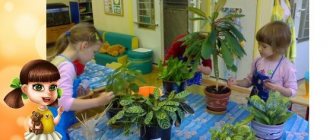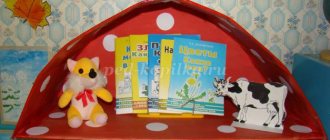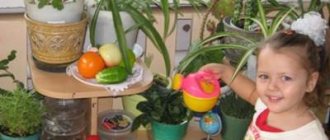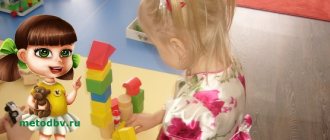What is important to consider when creating a natural corner in a kindergarten?
A living corner in a kindergarten is designed for each age group, taking into account sanitary standards, the age of the pupils and their capabilities.
SANPIN rules for preschool educational institutions 2.4.1.3049-13 clause 6.11. It has been established that placing animals, aquariums and birds in group rooms (dressing room, group room, bedroom, buffet, toilet) is not allowed.
Therefore, the main inhabitants of the corner will be plants: indoor flowers and a mini garden on the windowsill. The mini garden is made up of garlic, onions, oats and other crops grown in boxes in autumn and winter.
Requirements for the selection of plants
- Work in a corner of nature should be accessible to children in terms of time and strength, so plants are selected that are unpretentious in food and care.
- Plants should not be harmful to the health of children.
- Flowers for a corner of nature in a preschool educational institution should be selected from different types for comparison.
- When placing plants, you need to take into account their biological needs.
- The design of a corner of nature in a preschool educational institution must be done in such a way that preschool children can come up, observe, and do some work.
- Plants should have an attractive appearance that can attract and retain the unsteady attention of children.
The best corner of nature
Features of choosing indoor flowers for different groups
A corner of nature in the younger group should contain no more than 4-5 types of unpretentious indoor flowers. These are plants with distinct flowers, leaves and stems that bloom long and beautifully. Primrose, balsam, ficus, and geranium are perfect.
A corner of nature in the middle group should contain 5-6 species of plants. These are flowers with different sizes and shapes of leaves. In particular, agave, asparagus, chlorophytum.
In the corner of nature in the older group, 6 to 7 types of flowers are placed, 2 or 3 copies each. Plants must have different stems (creeping, climbing) and have bulbs or corms. These include ivy, tradescantia, amaryllis.
For the preparatory group, the number of plants is 6-7 species, which differ in the method of reproduction (bulbs, viviparous). For example, saxifrage, bryophyllum, cyperus.
When planning the design of a nature corner in a kindergarten, do not forget to provide a place to store work equipment, these could be:
- spray,
- watering can,
- cloths for wiping leaves,
- stick for loosening the soil,
- cups for seedlings.
In younger groups, the teacher monitors the cleanliness of the corner and instruments. In the senior and preparatory groups, this can be done with children (appoint a person on duty). The work of preschool children in a corner of nature is carried out in accordance with the curriculum.
Lessons in a corner of nature
Maria Skripnik works with children in the “Entertaining Zoology” and “In the Animal World” programs. During classes, the teacher tells the kids about animals, their diversity and role in nature. Children learn to care for pets, feed them, and monitor them. In addition to her classes, Maria is assigned to a zoo corner, where, as the manager and veterinarian, she monitors the health of animals, treats and cares for them, and conducts excursions for guests.
“The children and I also participate in events, holidays, promotions, conduct open classes such as “Bird Day”, “Pet Protection Day”, “Cat Day”, “Forest Day”, “Primroses”, “Feeder” campaigns, All-Russian lesson “Protected Islands of Russia”, we visit a pet store and a veterinary clinic. And in the VKontakte group “Zoo Corner” we post articles about the animal world, photos and videos of animals, classes and events of our organization,” says Maria.
Children at three to four years old and at five to six years old differ in the level of development of cognitive abilities. It’s enough for kids to simply watch fish and animals: the brighter they are, the easier it is for a child’s eye to catch on. With older children, you can grow plants from cuttings and seeds for a living corner, and study the habits of rodents and birds.
Natural corner in kindergarten: DIY decoration
When decorating a corner of nature in a preschool educational institution with your own hands, remember that it should contain a lot of visual material. The most significant of them is the nature calendar.
In a group for kids, it will be enough to place a picture depicting the current season. And also a doll dressed for the season.
For older children, there is a manual on the wall with pictures of the seasons and weather conditions with a moving arrow in the center. After the walk, you can discuss the weather with the children and move the arrow to the desired image. Also, in a corner of nature, it is necessary to set aside a place for children’s drawings on the topic of the observations made.
In older groups, children are introduced to symbols for indicating the weather. Every day, preschoolers mark weather fluctuations with conventional signs and at the end of the month they sum up the results: how many days were cloudy, how many sunny, windy, rainy. By the end of the year, the children will have an idea of the climate in their region.
A beautiful corner of nature in kindergarten
Often, a natural and ecological corner in a kindergarten is combined into one and, in addition to the above, the following is placed in it:
- a set of pictures with birds, insects, domestic and wild animals, plants;
- dummies of vegetables and fruits;
- children's crafts made from natural materials;
- equipment for conducting experiments - molds, containers of different volumes, spatulas, measuring spoons. You can conduct didactic games and experiments with water, sand, stones, shells, and clay to study their properties.
Activities in a corner of nature contribute to the development of work skills in preschool children. Already in the younger group, the teacher involves children in carrying out feasible work assignments. In the older group, corner duty is introduced.
Working in a corner of nature gives children a lot of pleasant experiences. Preschoolers learn to understand the world around them, to notice both general and individual signs of natural objects, which leads them to an understanding of the uniqueness and diversity of living organisms. Communication with nature stimulates children's thirst for creativity. A properly organized living corner is a powerful educational tool in the aesthetic, psychological and moral development of children.
Corner "Eco-children - preschool children" teaching aid
Municipal preschool educational institution – kindergarten No. 21 “Fairy Tale”
Address: 142207, Moscow region, Serpukhov, Central, 177
CORNER PRESENTATION
"Ecolyats - preschool children"
The corner “Children - Preschool Children” includes many components: a stand, a mobile folder, laptops, visual material, educational games, riddle cards, a card index of experiences and experiments, a herbarium, children’s literature on environmental topics, encyclopedias.
Stand size: 50 x 100 cm.
Sliding folder size: 6 sheets of A-3 cardboard, with flexible connection.
Material: environmental materials: thick cardboard, paper, felt.
Color: the stand is white (the materials are clearly visible to children), the background of the folder is green - it is mobile, symbolizing our planet, greenery, grass.
Decoration of the corner: the stand constantly displays images of fairy-tale characters - eco-children (Quiet, Naughty, Herringbone, Clever), the logo "Eco-children-preschool children". The rest of the material (photos depicting environmental actions) changes periodically.
The material on the stand is easily attached, so updating the stand is accessible to children. They are happy to do it on their own.
The folder "Ekolyata" is made of environmentally friendly materials: felt, cardboard and paper.
It has 6 pages.
- The first page contains the “Ekolyat” logo and the oath “Ekolyat – young defenders of nature.” The oath itself is decorated with flowers, leaves and insect figures made of felt. Felt is felt fabric obtained by pressing wool. Figurines of fairy-tale characters “Ekolyat” and the “Ekolyat” logo were made from different pieces of felt. Children together with their parents took an active part in creating the composition. Everything is located on a green background.
- On the second page of the travel folder there is the oath “Ekolyat”. The page itself is also decorated with felt figures and flowers.
- The third page contains the slogan – the call “Take care of insects”. The game “Name the Insect” has been created for preschool children. The goal of the game is to reinforce the names of insects with children and teach them how to treat them with care.
- The next page contains the slogan “Explore Nature” and the game “Seasons”. All details of the game are made of felt. The pictures are attached to rigid adhesive tape. The game promotes learning about the seasons. Children not only get acquainted with the seasons, but also study natural phenomena at different times of the year.
- It is very important to teach children to care for animals. And best of all, children, especially young ones, perceive information through play. Therefore, on the fifth page there is a game “Find Mom”. Irga is made of felt. Children repeat the names of animals and their babies. The page's slogan is "Caring"
- The sixth page of the moving folder is intended for the most creative and imaginative children. It is called "Drawings of eco-children - preschool children." The guys depict animals, birds, insects, natural phenomena, etc. and place them in a folder. The folder can also be used for thematic drawings. For example: “Red Book”, “Take care of nature”, “Take care” (for children of older preschool age).
In the corner “Eco-children - preschool children” a card index of experiences and experiments has been selected.
Children collect herbariums and natural materials, read poems, stories, riddles, from which they learn a lot about nature, and make crafts.
Children learn to preserve and protect nature, learn the rules of behavior in nature.
There is a large toy library “Whose trace?”, “Find where they hid”, “Who lives where?”, “The world of plants”, “Wild animals and their young”, “Air, earth, water”, Lotto “Birds” and etc.
The purpose of this corner is to instill love and respect for our native nature, its flora and fauna. This corner helps: to understand the inextricable connection between man and nature, its value for humans; to form a culture of love for nature in children; the child will understand the importance of preserving, protecting and saving nature for the survival of humanity on earth; broaden their general horizons and promote the development of children's creative abilities.
For each season, thematic folders have been developed, which contain material and tasks about animals, insects, birds, and natural phenomena.
Natural corner in kindergarten (photo)
Which animals to choose
“In our living area there are mainly unpretentious pets: Syrian and Djungarian hamsters, rats, gerbil mice, akomis spiny mice, rabbits, guinea pigs, budgies, and fish,” says Maria Skripnik. “But there are also those who need to create special conditions for a full life: Central Asian and red-eared turtles, chinchillas, degus, Achatina snails.”
Who can be accommodated in a zoo corner?
Fish
It is useful to choose fish of different breeds so that children can compare them and find differences. The most unpretentious breeds are considered to be guppies, swordtails, barbs, cardinals, zebrafish, catfish, and goldfish. It is better to place the aquarium in a cool, dark place away from the window.
Some types of fish cannot be kept in the same aquarium. For example, schooling barb fish do not get along well with smaller breeds (they simply eat them or bite off their fins), and also conflict with goldfish. The best neighbors for them will be swordtails, zebrafish, and parrotfish.
In addition, it is necessary to take into account the purity, hardness and acidity of the water. Guppies cannot stand dirt in an aquarium, so they do not get along well with goldfish. You should find out about all this in advance from a consultant at a pet store and read in specialized literature.
Reptiles
An interesting exhibit is a chameleon. By watching him, children learn about the phenomenon of mimicry. Land and waterfowl turtles will take root in the zoo corner.
“But turtles require a large aquarium or cage, an ultraviolet lamp for heating, and special food,” warns Maria Skripnik.
Waterfowl require an aquarium with rocks. Moreover, some of the stones should be located above the water so that the turtles can crawl onto land and bask under the lamp.
Rodents
It is allowed to keep rabbits, guinea pigs, mice, rats, and hamsters in the zoo corner of a preschool institution. Maria Skripnik says that each type has its own characteristics of content:
“For rabbits, rats, and guinea pigs, you have to clean the cage often and feed a lot. But spiny mice do not require frequent changes of bedding, they drink little, are unpretentious in food, but they love to live in the company of their relatives. Hamsters, on the contrary, prefer to live alone. They don't need a large cage, they don't eat much, and they're easy to care for. Some animals (hamsters, chinchillas, rats, Achatina snails) are more active at night and sleep during the day - it’s more interesting to watch them in the evening.”
If rodents live in cages, then they should be placed at a short distance so that the inhabitants of neighboring cages cannot injure each other. If animals are kept in aquariums, there is no such need.
Living corner in MBU DO "CD (Yu)TT" Salavat
Birds
Usually the zoo's corner is home to budgies, canaries, rosellas, cockatiels, and greenfinches. They are easy to care for, have bright colors and are popular with children. In addition, some species breed in captivity, which means kids will be able to watch the emergence and growth of chicks. There are species of parrots that exhibit strong sexual dimorphism—the difference in appearance between males and females. This is also a topic for class.
Plants
Plants can be conveniently divided into climatic zones. For example, imagine the tropical zone with ficus, chamedorea. The desert - aloe and other succulents, the subtropics - azaleas and geraniums.
During classes in the zoo corner, the child is involved in various types of activities: play, work, observation, discussion. This promotes comprehensive, diversified development. A living corner will give preschoolers extensive knowledge about nature and instill a love for the world around them. Getting acquainted with living nature, the child will develop morally, spiritually and aesthetically.








